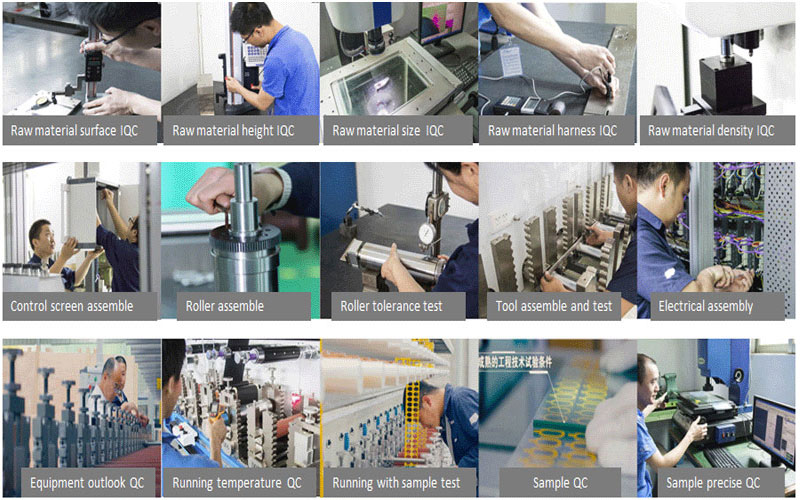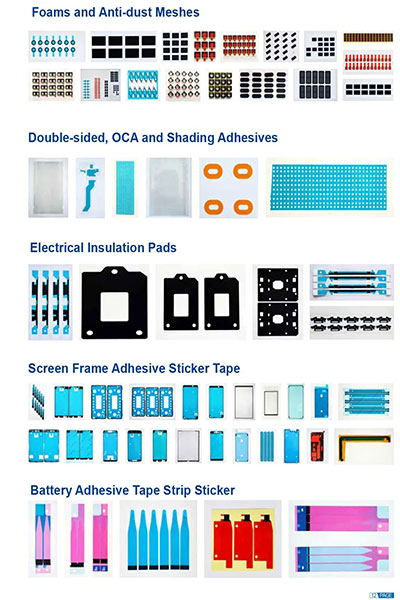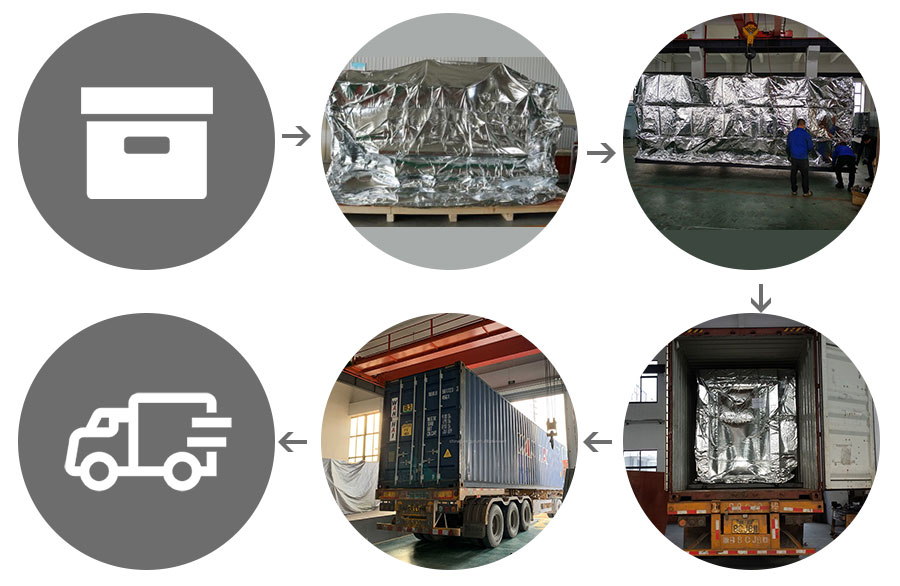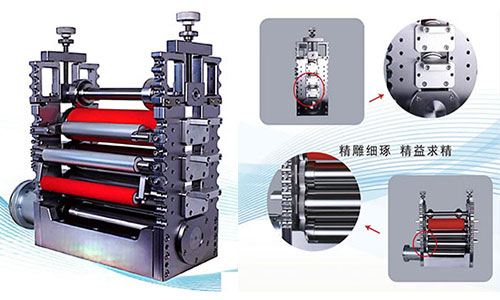Mode: FMT250-24B
Stations: 24 Stations / 48 Spindles
Width range: 150/250/350/550/650mm
Max speed: 60m/min
Cutting precision: ±0.1mm
Size: 8800*1420*2350mm
Weight: 10T
Certification: CE & ISO
Quick-change modular various design
rotary die cutting machines play a crucial role in various industries, including the manufacturing of electronic circuit board, dust-proof foam nets, conductive/insulation pads, medical and cosmetic products, ultra-high frequency radio frequency identification (RFID) tags, graphite thermal insulation pads, and screen frame adhesives, among other
PLC servo control system to ensure high precision and constant tension.
All consumer electronics products share one machine, save money.
Modular design allows different machines combine flexibly, such as packaging machine combine with die cutting machine, printing machine combine with die cutting machine; the stations can be removed or added, so when you have new products after buying, you can use the same machine by changing tools or stations instead of buying a new machine.
Our excellent R&D team can customize the machine according to your requirements and products type, and advise the most suitable machine for you.
We can recommend raw material suppliers for you, and provide you a whole solution besides the machine.
Characteristic:
Module design: One machine, by changing tools or adding apparatus (below details), can cover most of the industries, such as Medical and Cosmetic, Anti Dust Foams Meshes, Conductive Insulation Pads, Graphite Thermal Pads, Screen Frame Adhesives, UHFHF RFID Tags Labels, etc.
ALL cutter holder's movements are controlled by JAPAN Omron servomotor with enough torsion, stable acceleration and deceleration, precision can be ±0.05--±0.1.
All unwind & rewind shafts are driven separately by servo motors. The unwinding, rewinding, straight & reverse rotation are more flexible and controlled by high sensitivity tension sensor shaft's feedback to ensure smooth running.
It can save more 200 kinds of SOP data, improve standard level, and reduce dependence on Operator's experience and reduce more than 60% material waste
Main unwind EPC system can stabilize the material feeding into blade holder
Movable auxiliary unwind shaft
Fracturing detecting machine stop or alarming to reduce material waste.
Machine has the function of asynchronous laminating which can save material.
Color code electric eye tracking system can meet the demand of position precision of produce printing product.
The main operation interface adopts touch panel, with picture display for easy operation. Keyboard, mouse and hand touch are all available.
CCD testing system can test position precision all the time during the whole process and then feedback to PLC which send orders to servo motors to adjust position.
Intelligent tension system | die-cut tool-station | CCD system | Incoming deflector |
|
|
|
|
converting, laminating, indexing, autotuning, CCD alignment, extremely fast and precise
Slitting --- laminating --- die cutting --- discharging waste material --- rolling the useful material, and this process will be done repeatedly upon your product's craft ship.

After-service:
§ Engineers be dispatch to customers place for training and debugging
§ One year free warranty (except consumables), life paid maintenance and overseas service
Advantages:
The advantages of using a rotary die-cutting machine in the production of FPC (Flexible Printed Circuit) are as follows:
1. Precise and Accurate Cutting: The rotary die-cutting machine ensures precise and accurate cutting of FPCs, providing consistent and high-quality results.
2. High Production Speed: The machine operates at high speeds, allowing for efficient production of a large number of FPCs within a short period of time.
3. Versatility: The rotary die-cutting machine can handle various shapes, sizes, and designs of FPCs, accommodating diverse customer requirements.
4. Cost-effective: By automating the cutting process, the machine reduces labor costs and increases productivity, resulting in overall cost savings for FPC production.
5. Minimal Material Waste: The machine optimizes material usage, minimizing waste and optimizing production efficiency. This helps to reduce costs and improve sustainability.
6. Enhanced Efficiency: The rotary die-cutting machine operates seamlessly with other production processes, ensuring smooth workflow and efficient FPC manufacturing.
7. Consistent and Repeatable Results: The machine delivers consistent and repeatable cutting results, maintaining uniformity in FPC production and minimizing errors or defects.
8. Reduced Manual Intervention: The automation provided by the machine reduces the need for manual intervention, minimizing the risk of human errors and improving safety in the production process.
9. Increased Design Complexity: The rotary die-cutting machine enables the production of intricate and complex FPC designs, expanding the range of possibilities for product development and customization.
1. Flexible Printed Circuit (FPC): It can cut and shape FPCs into desired shapes and sizes for use in various electronic devices.
2. Labels and Stickers: The machine can die-cut labels and stickers from different types of materials, such as paper, plastic, and vinyl.
3. Gaskets and Seals: It can cut gaskets and seals from materials like rubber, foam, or silicone, which are used in automotive, industrial, and other applications.
4. Packaging Materials: The machine can cut and shape packaging materials, such as cardboard, corrugated board, and foam, for making boxes, inserts, and protective packaging.
5. Membrane Switches: It can cut and shape membrane switches, which are used in control panels, keyboards, and other electronic devices.
6. Insulation Materials: The machine can cut insulation materials, such as fiberglass, Mylar, or Nomex, for use in electrical equipment or HVAC systems.
7. Automotive Interior Parts: It can cut and shape materials like leather, fabric, or foam to produce automotive interior parts like seat covers, headrests, and armrests.
8. Medical Components: The machine can cut medical components, such as medical-grade tapes, filters, or foam pads, used in medical devices and equipment.
9. Industrial Components: It can cut and shape various industrial components, such as gaskets, pads, spacers, or washers, made from materials like rubber, foam, or PTFE.


Packaging
1. Inner Package: Vacuum PET film
2. In Containers , By sea

|
|
We offer one-stop solution, including automatic equipment design, manufacturing, and customerized, OEM/ODM service, etc.
Rotary tooling:

| rubber-shaft | rubber-roller | press roller | die-cutting press system | |||
|
|
|
| |||
| die-cut tool station | spindle-tool | sliding-block | silicon-rubber-roller | |||
|
|
|
|
OEM/ODM
We also provide Outsourcing Services, for those factories whose temporary peaks in production need fulfilling and uncertainty about machine investment for in-house operation.
How does a rotary die cutting machine differ from a traditional stamping press?
A: A rotary die cutting machine utilizes cylindrical dies and a continuous rotary motion to cut materials, offering higher speed and efficiency compared to the stop-and-go operation of a traditional stamping press. Rotary die cutting machines are particularly suited for high-volume production and can handle a variety of materials with precision.
What are the key factors to consider when selecting a rotary die cutting machine for a specific application?
A: When selecting a rotary die cutting machine, important factors to consider include the type and thickness of the materials to be processed, the desired cutting speed and accuracy, the level of automation required, available space and budget constraints, and any specific customization needs for the application.
How does the die design impact the performance of a rotary die cutting machine?
A: The design of the die used in a rotary die cutting machine directly influences the quality and efficiency of the cutting process. Factors such as the shape, size, and configuration of the cutting blades, as well as the material and hardness of the die, can affect the precision of cuts, the durability of the die, and the overall productivity of the machine.
What are some common maintenance procedures for rotary die cutting machines?
A: Routine maintenance procedures for rotary die cutting machines typically include regular cleaning and lubrication of moving parts, inspection and replacement of worn or damaged components, calibration of cutting blades and pressure settings, and software updates for control systems. Proper maintenance helps to ensure optimal performance, minimize downtime, and prolong the lifespan of the machine.
How can rotary die cutting machines contribute to the sustainability goals of a manufacturing operation?
A: Rotary die cutting machines can contribute to sustainability goals by reducing material waste through precise cutting and nesting of parts, optimizing production efficiency to minimize energy consumption, and enabling the use of eco-friendly materials and processes. Additionally, advanced control systems and monitoring capabilities can help manufacturers track and reduce environmental impacts throughout the production process.
What are the advantages of rotary die cutting machines compared to flatbed die cutting machines?
A: The main advantage of rotary die cutting machines is their higher speed and efficiency, as they can continuously feed and cut materials in a rotary motion. This results in faster production rates and reduced downtimes compared to flatbed die cutting machines, which operate in a stop-and-go manner.
What types of materials can be processed using rotary die cutting machines?
A: Rotary die cutting machines are versatile and can process a wide range of materials, including paper, cardboard, plastic films, rubber, foam, textiles, adhesive tapes, and various types of composites. They are commonly used in industries such as packaging, electronics, automotive, medical, and printing.
What are the emerging trends in rotary die cutting machine technology?
A: Some emerging trends in rotary die cutting machine technology include the integration of automation and robotics for increased precision and efficiency, the development of more advanced control systems for enhanced user interface and data management, and the incorporation of laser cutting technology for intricate and complex cutting requirements. Additionally, there is a growing focus on sustainability and eco-friendliness, with manufacturers exploring ways to reduce material waste and energy consumption in rotary die cutting processes.
Contact: Pamela
Phone: +86 189 6365 3253
E-mail: info@industryprocess.com
Whatsapp:+86 189 6365 3253
Add: Yajing Industrial Park, No. 59 Shuangjing Street, Weiting Town, Suzhou Industrial Park
We chat
